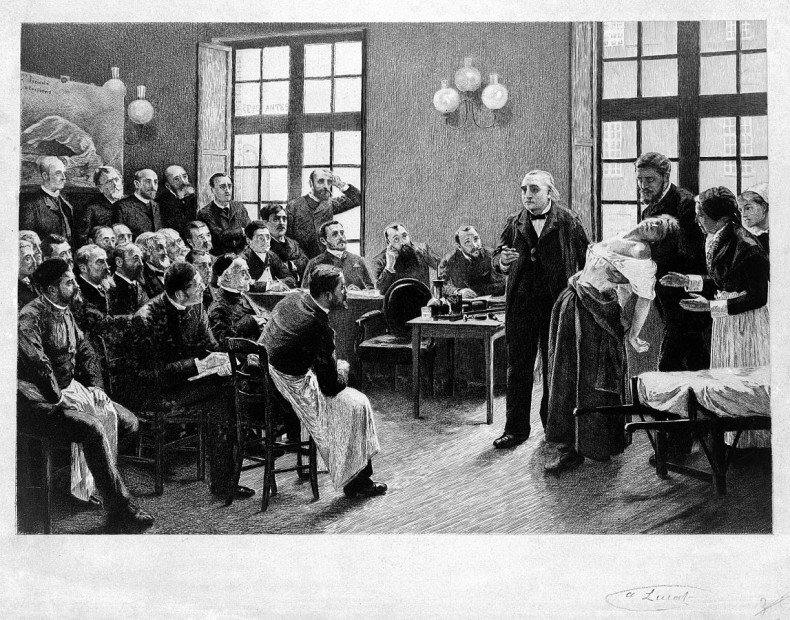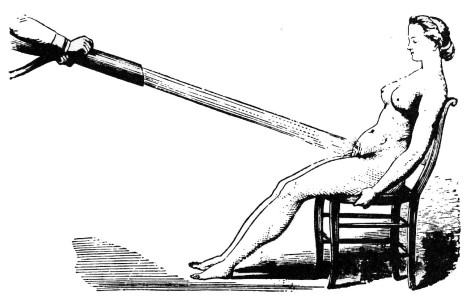
Okay, ladies, it’s high time we ceased the knuckle biting and the swooning, the weeping and the throwing of things, and certainly the touching of our own private parts in lieu of honoring the phallus. Someone might think we’re hysterical.
For as long as men and women have coexisted, which is pretty much the whole time, men have wished they could “fix” the things we girls do that irritate or flummox them. Corralling many symptoms under one label makes that easier, or at least it did for the earliest physicians. We can thank Hippocrates (460-377 BC) for the term “hysteria” (from hystera, literally ‘uterus’)—which nicely summed up a whole host of issues that we’ve now separated out into mostly psychological and neurological disorders, including depression, chronic fatigue syndrome, fibromyalgia, schizophrenia, bipolar disorder, epilepsy, asthma, PMS, horniness, and lack of horniness (aka, “the headache”).
I won’t try to shovel 4,000 years of thinking about female hysteria into this wandering text, but here are some of the best bits—gleaned from scholarly papers that you could have read instead of this, had you Googled “female hysteria” and done some intelligent clicking. (I’ve listed those excellent sources at the bottom with links, to give credit where it is due.)
Pre-Hippocrates, lady problems were familiar but not yet consolidated and named. I can envision some sideways-standing Egyptian “diagnostician” on a gloomy afternoon around 1900 BC whipping out a sheet of papyrus and jotting notes about “curious behavioral disturbances” in his female patients; after much stroking of his unnaturally pointy beard, he comes up with the cause: a migrating uterus! (Yells Greek equivalent of Eureka!)
Why a womb would wander one can only wonder. Debate ensued and lingered: Was it feminine weakness, biological error, or demonic invasion sending the womanly organ out of whack? (Ridding a woman of the last one could mean waving fire around her privates or giving her a good hosing out—see illustration below, of the purifying douche of all purifying douches). By 1600 BC, the cure was, thankfully, lower impact: aromatherapy, done by placing malodorous and acrid substances at the nose of the patient and fragrant ones at the vagina, or vice versa, depending on the womb’s path. No doubt this was extremely effective.
By 1600 BC, the cure was, thankfully, lower impact: aromatherapy, done by placing malodorous and acrid substances at the nose of the patient and fragrant ones at the vagina, or vice versa, depending on the womb’s path. No doubt this was extremely effective.
The Greeks, around 400 BC, ran with the wandering womb hypothesis, maybe enjoying its alliteration. Plato wrote of the “animal” within women that, when not procreating, “gets discontented and angry, and wandering in every direction through the body drives them to extremity, causing all varieties of disease.” Hippocrates, of “let’s call it hysteria” fame, described the too-light uterus bumping into other organs as it migrated, with effects like constricting the breath, setting off anxiety, stealing the voice, tensing the jaw, and so on.
In those olden days, to push the wandering uterus back into place one could bandage the lower belly and hold the nostrils while sneezing, for starters. Also, inhaling or ingesting certain pungent substances could send the maverick organ south, or sticking a minty-fresh pessary up the vagine might lure it north. [Today, pessaries, which are small plastic rings or other-shaped devices, are commonly used to treat prolapsed uteruses, so the Greeks were on to something there.]
But that was all just foreplay. Pessary schmessary…the truth is that a floaty uterus suggested “sexual starvation,” according to the men in robes. So to stop it floating for good, a woman really just needed to get laid.
Said these men of science, a woman needs to have sex to widen her canals and clean out her bodily humours. Stagnant humours, after all, are prone to putrefaction. And you don’t have to be Doc Hippoc to know that uterine fumes stuck in tight spaces can’t be good for a girl’s thisthat and whatnot. Such constriction might even cause her to get a touch of the vapours, of which hysteria was a common manifestation. Whether Hippocrates offered himself up as a treatment tool isn’t reported, or such report was shredded before the best man at Hipp’s wedding could get his hands on it. (Imagine the uncomfortable silence after that toast.)
Romans (400 B.C. to 400 A.D.) abandoned the wandering womb; some instead proposed inflammation and constriction was the problem, leading to the description of hysteria as “suffocation of the mother” (Sonarus of Ephesus ); others theorized that symptoms were a sign of retention of menstrual blood (Galen of Pergamon) and also of semen during periods of abstinence. Semen contained an “evil essence” that led to hysterical fits in woman—and also in men (although more in the former because women were seen as weaker, you see). For both sexes, Galen proposed treatments aimed at cleaning out that evil stuff.
You know how. Sexy stuff (in married pairs or, for men, solo, in a pinch).
Let’s skip ahead a bit. Not that stuff didn’t happen in between, but I never promised a complete history, just an entertaining one. In Victorian days, doctors further broadened female hysteria, adding to irritability, fainting, purposeful vomiting, and frustrated outbursts new symptoms such as assuming “masculine privileges and modes of life” (eeek, early feminists!). Plus, erotic thoughts and feminine lubrication (without a husband’s involvement) were unhealthy. Pelvic massage to “hysterical paroxysm” (orgasm) was the preferred treatment, and doctors themselves readily performed it. Whether effective or not, it no doubt made for awkward dinner conversation back home. (‘How was your day, my beloved Maximus?’ ‘Nothing special, my dear Cesira. I cured five hysterical ladies by placing my hands up their gowns and rotating their pillowy parts until they vibrated with pleasure. Would you please pass the fricasse?’)
(In truth, there is no evidence, according to scholars, that doctors enjoyed these hands-on treatments, seeking whenever possible to employ the husband’s or a midwife’s hands or the rounded end of some impersonal implement. The vibrator came out at the end of the 19th century. Whew.)
Aside from a mobile uterus and stuck fluids, this “disease” was linked at times to animal spirits, to witches, to God’s wrath against sin, to the devil. Psychologists and neurologists fought for ownership of the disorder. Unrequited love and sexual desire appeared over and over as a cause. Sex was often part of the cure. Throughout, women were described as weak in the face of their faulty biology or the sorcery that plagued them, whichever was in vogue. And while I write flippantly about its history, a lot of women were despised, tortured, and murdered (especially during the Middle Ages and the Renaissance before the Enlightenment) for hysterical behavior in its many forms. Sadly, those women were often very ill with very real neurologic or mental (or other) problems that were entirely misunderstood for generations.
Meanwhile, I’d like to give a shout out to the “founder of gynecology,” Greek physician Soranus of late in the 2nd Century A.D., who stepped out of line to suggest that women’s disorders “arise from the toils of procreation” and that their recovery would occur not with more sex but with sexual abstinence. Plus, “Fumigations, cataplasms and compressions are ineffectual, the hysterical body should be treated with care: hot baths, massages, exercise are the best prevention…,” he wrote. I imagine this sweet, gentle man couldn’t get tenure, his writings placed on a high shelf, or redacted.
Freud gets credit for seeing hysteria as an affliction of both sexes; he of course plopped it squarely in the mental health category, explaining it as horrible or embarrassing memories converting into physical symptoms. He called it “conversion hysteria” and treated it, along with many other “neuroses,” with psychoanalysis/talk therapy. Meanwhile, as medical thinkers thought harder and broke hysteria into the different disorders that it really was, each with its own name, causes, and treatments, “female hysteria” of yore, with its everything-but-the-kitchen-sink symptom list, eventually faded. But it took until 1980 for hysterical neurosis, perhaps the last of hysteria’s many forms, to fall out of the Diagnostic and Statistical Manual of Mental Disorders (DSM)-III.
Is it really gone, though? Ask your average modern man about female hysteria, and he’ll probably roll his eyes and share the agony of his dealings with the “crazy” women in his life. While no longer an official medical term, hysteria remains in our lexicon as an often insulting description of “overwrought” or completely illogical behavior in women. (That’s not its only use, of course. But isn’t that what comes to mind when hearing the term without context?)
Just thinking about that makes me hysteri…I mean, pissed off enough to throw stuff around. We ladies are emotional beings, which I propose is a positive thing. Outbursts reveal our passion. Indecision shows our balanced thinking. High expectations should be praised. Masturbation is perfectly natural. And if it turns out that a woman’s womb has wanderlust and is fixing to move? I say, you go girl. You go.
——-
Photos from Wikimedia Commons, and aren’t they grand? The top one illustrates Jean-Martin Charcot (who studied with Freud but believed hysteria was neurological rather than psychological in nature) demonstrating hysteria in a patient, 1887. The lower drawing shows an early French douche for treating hysteria, from 1860. Yikes.
Everything I wrote here about female hysteria I gleaned from these fine sources:
Hustvedt, A. Medical Muses: Hysteria in Nineteenth-Century Paris (2011), or to be more specific, a review of the book on Morbid Anatomy, http://morbidanatomy.blogspot.com/2011/06/new-and-perfect-book-on-hysteria.html
Illis, L.S. “Hysteria,” Spinal Cord (2002) 40, 311-312. http://www.nature.com/sc/journal/v40/n7/full/3101327a.html
Maines, R.P. The Technology of Orgasm: ‘Hysteria,’ the Vibrator, and Women’ s Sexual Satisfaction. (1999) http://www.nytimes.com/books/first/m/maines-technology.html
Morris, J.G. et al., “The history of hysteria,” in The Pharos of Alpha Omega Alpha-Honor Medical Society. Alpha Omega Alpha 67(2):40-3 · January 2004 http://www.ncbi.nlm.nih.gov/pubmed/15214243
Tasca, C. et al., “Women and hysteria and the history of mental health,” Clin Pract Epidemiol Ment Health. 2012; 8: 110–119. http://www.ncbi.nlm.nih.gov/pmc/articles/PMC3480686/
Thanks for a great article on hysteria. I’d also like to mention that some very real and very painful physical diseases were also mistaken for hysteria such as endometriosis, which has a rate of occurance of about 1 in 10 nowadays, and there is no reason to suppose it wasn’t the same in oldentimes. Sadly there is still a lot of misinformation and shoddy treatment of this disease today, however, a good resource is endopaedia.info. Also, March is endometriosis awareness month so this is a fitting time to make a plug!
Thanks for your comment! Excellent addition to the list. I think anything that was “idiopathic” at the time was probably fair game. Women certainly did their fair share of suffering….
My question stems from the females taking all this crap ( literally). Were we really that immune to female fact and fate to gobble up ( not literally) all that shit? I must admit, my dinner is cheerfully cooking in the oven while my stomach is twisting to a new thought of not desiring to eat at all. I still seem able to take the information just read and have a nice serving of ice cream , probably my favorite, Hagaen-Daz Coffee. I will not be sharing this treat with any male friend. I did turn off the oven however. Not in the mood to eat. I know my husband has a meeting after work today but told me to be “In the mood” when he arrives home. I may swoon just thinking about it.